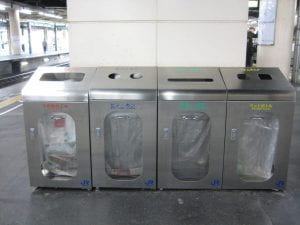Welcome back! Let’s talk about Japan’s plastic usage and recycling culture this week.
Before I embark on the topic, I would like to bring your attention to the types of recycling bins that are available on a typical Japanese street.

Certainly, segregating recyclables into their specific categories is the primary step in recycling, and the Japanese do a remarkable job at it. However, the processing stages involved in Japanese recycling industries may be a little more complex. Let us focus on plastic recycling.
Do you know that the plastic recycling rate in Japan is 84%? Honestly, that is considerably high. The rest of the plastic wastes are either burnt or discarded in landfills.
Plastic recycling in Japan is categorized into 3 groups-thermal, material, and chemical. Thermal recycling (incineration of plastic waste to generate energy) constitutes nearly ¾ of the plastic recycling process in Japan. Even though this might be seen as an efficient way to maximize the use of alternative raw materials that can be combusted to generate energy, it is worrisome since burning plastics releases lots of harmful greenhouse gases (GHG) and contributes to global warming. However, Japan seemed to have devised a novel and cleaner way of burning plastics that release carbon dioxide instead of more potent and harmful air pollutants. Despite that, carbon dioxide is still a GHG that contributes to global warming and in my opinion, would not be the best way to deal with climate change in the long run.
I am inclined to think that even with all the current plastic recycling measures, there is still no single 100% efficient way of recycling. Hence, the best way to prevent any loopholes in plastic recycling is to collectively reduce public reliance on plastic.
Despite being a small nation, Japan ranks 5th in global plastic waste production. One plausible reason contributing to such large numbers of plastic waste is Japan’s prevalent use of single-use plastics. And it doesn’t stop there. Japan’s slavish usage of plastic shopping bags in grocery stores and supermarkets is surprisingly high too. Have you ever wondered about the amount of plastic used in Japanese takeaway bento sets? Japanese food consumerism habit implies that considerable amounts of effort are put into food packaging to make the products seem more appealing and presentable. (Refer to my previous blog on food presentation)

There are so many ways that Japan can reduce plastic usage such as increasing its use of biodegradable plastics, using eco bags during grocery shopping, or even just using their own reusable containers for takeaway bento sets.

From my perspective, Japan still requires a bit of work in its plastic usage and recycling endeavors. What do you think?
-Wen Han
(Photo by mali maeder from Pexels)

Hi Wen Han!
I always had the idea that Japan is a minimalistic country that uses much less items and hence produce less waste. It’s really shocking to know that Japan is the world’s fifth largest producer of plastic waste! However, they do have much higher recycling rates as compared to Singapore which only recycles 4% (https://www.nea.gov.sg/our-services/waste-management/waste-statistics-and-overall-recycling) of our plastic waste.
What do you think Japan is doing right in recycling to obtain such high recycling rates for plastic waste? Can Singapore adopt similar measures?
– Jo
Hi Jo, thanks for dropping by my post! I feel that the reason why Japan is able to outcompete Singapore in terms of plastic recycling is the public awareness of this topic.
According to this report, Singaporeans do not know where and what to recycle and often discard general trash into plastic recycling bins, contributing to the inefficiency in the actual recycling processing itself. Furthermore, there is a lack of a wider range of recycling bins in Singapore (you might have only seen the blue recycling bins in your neighborhood). Japanese on the other hand has the 3Rs culture deeply integrated into their culture since the post-war periods (Check this article out) In addition, it is a common sight to see a wide array of recycling bins in Japan designated for different types of recyclables, which makes recycling on an individual scale much more convenient and intuitive.
Overall, I feel that the general public in Singapore should be more well-educated on the different aspects of recycling and how recycling plastics can go a long way in protecting the environment.
Hi Wen Han,
Could I please ask you to explain what you mean by the following statement ?
“Despite being a small nation, Japan ranks 5th in global plastic waste production.”
Meaning, I don’t understand your characterisation of Japan as a small nation considering that it has > 126 million ppl and is ranked 11th globally in terms of population size.
So, considering that Japan is, after the US, the wealthiest nation (per capita GDP) in the top 15 countries by population, to me, the fact that its total plastic generation ranks 5th suggests less reliance on plastic than expected based on population size & affluence.
Not sure if you get where I’m coming from, but would appreciate knowing your thoughts.
thanks,
jc
Hi Dr. Coleman
Perhaps I was vague in this statement, so allow me to rephrase it. What I meant was Japan had a much smaller population size and landmass than big countries such as China, the USA or Brazil. However, it is one of the biggest consumers of plastic and contributor of global plastic waste, since it is able to make it to the top 5 on the list of plastic waste producers. In fact, Japan is the second-highest plastic packaging waste producer after the USA (Plastic packaging is the leading factor in the industrial sector contributing to plastic waste). Therefore, I was trying to pull the attention of my audience into visualizing that Japan, despite being a lot smaller (in terms of population size and landmass) than China or USA or Brazil, uses a large quantity of plastic.
Certainly, I could not deny the fact that the per-capita GDP of a country does contribute to its plastic consumerism habits. One example was Germany that ranked 3rd had both a smaller landmass and a lower population size of ~83 million people than Japan (~126 million people). However, Germany’s per capita GDP (~$47k) was higher than Japan’s (~$40k). That probably contributed to Germany’s higher plastic wastage than Japan. Per capita GDP was perhaps something I may have overlooked pertaining to plastic wastage.
Hope that this clears your doubt on this sentence.
Thanks so much for explaining !